
Common name:Fox Tail Agave, Velvet Agave
Botanical name:Agave attenuata
This Agave has a dramatic tropical form. Even light frost can damage its succulent leaves. It is great for containers. In the low desert, partial sun will be best. If it becomes top heavy, simply cut and stick in the ground to root. It is not a fast grower and has light green foliage. It will also die after flowering but pups around the mother will survive. Distinctive with its large rosette of leaves perched on a long curving trunk, it is a native from Mexico.
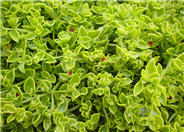
Common name:Red Apple Aptenia (Ice Plant)
Botanical name:Aptenia X cordifolia 'Red Apple'
Aptenis is a herbaceous perennial groundcover with fleshy heart shaped leaves on succulent stems. Tiny, solitary red flowers appear among leaves. Foliage is shiny and bright green. It is salt tolerant and great in containers, planters or hanging baskets. It needs full sun or light shade. Be careful not to overwater. It can die back with heavy frost and will not tolerate foot traffic.

Common name:Society Garlic
Botanical name:Tulbaghia violacea
This clumping perennial will grow less than 1' tall and has narrow, blue green leaves. Clusters of lavender flowers bloom in spring and summer. Leaves and flowers have a distinct onion or garlic smell if crushed.

Common name:Snow-In-Summer
Botanical name:Cerastium tomentosum
Masses of snow white flowers highlight this plant during the early summer season.
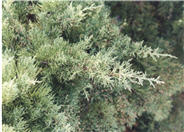
Common name:Blue Pfitzer Juniper
Botanical name:Juniperus X pfitzeriana 'Glauca'
Broad, vase-shaped evergreen shrub branches spread and angle upward can get to 20' tall. This Juniper has a moderate growth rate with feathery, gray green foliage. It needs full sun to part sun in the low desert. It is susceptible to mites, bagworms, aphids, and Juniper blight. Junipers are highly combustible plants.
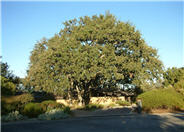
Common name:Coast Live Oak
Botanical name:Quercus agrifolia
The Coast Live Oak is an evergreen round headed tree. It can reach 15'-40' high and 20' wide; it grows very well from the coastal areas to the interior valleys. It is native to California, is drought tolerant, and attracts butterflies. -Cornflower Farms
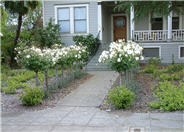
Common name:Tree Roses
Botanical name:Rosa Tree varieties
Tree roses are actually shrubs that have been grafted or grown in a way that looks like a tree, ie with a trunk. Tree roses can be floribundas, hybrid teas, or grandifloras. They are typically used as specimen plants. Make sure the plant is tied to a stake in case of strong winds.

Common name:Crape Myrtle
Botanical name:Lagerstroemia indica
The new leaves of this species are 2" long, bright green, and tinged with bronze. Its fall color is affected by the weather. While it has a bare outline, its rounded seed capsules add interest. Its delicate flowers bloom in 6"-12" long clusters. The colors of its flowers are shades of red, rose, pink, purple, and white. It thrives on heat and new cultivars have been created that resist mildew.

Common name:Chinese or Evergreen Elm
Botanical name:Ulmus parvifolia
This evergreen tree will grow about 40'-60' tall and 50'-70' wide. It has leathery, dark green leaves and round fruit in the fall. It grows quickly to provide a beautiful shade tree. Bark exfoliates in the winter providing various colors. Foliage turns yellow, gold, orange, red or purple. This tree is lovely all year round but tends to be messy with falling fruit.
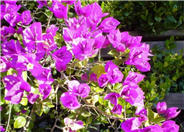
Common name:Bougainvillea
Botanical name:Bougainvillea spectabilis
This species is hardy and vigorous, with a showy, ornamental display of purple color. It blooms well in areas with cool summers.

Common name:White Birch, European White Birch
Botanical name:Betula pendula
This medium-size weeping tree will grow to about 40' tall and has a whitish/brown bark with deciduous green leaves.
| Designer: | Aptenia and Friends |
Photographer: GardenSoft |
Soils and Compost:
Practice grass-cycling by leaving short grass clippings on lawns after mowing, so that nutrients and organic matter are returned to the soil.
Water Saving Tip:
Apply a layer of mulch around plants to reduce moisture loss.
Choose organic mulches, such as shredded bark, compost or aged sawdust.
Integrated Pest Management:
Drip and other smart irrigation delivers water directly to roots, allowing no excess water for weeds.
